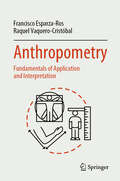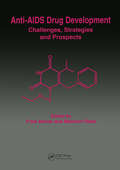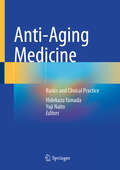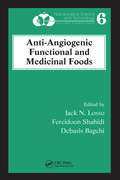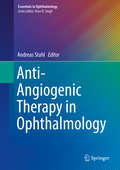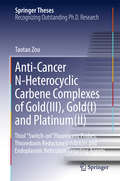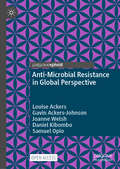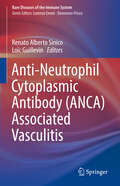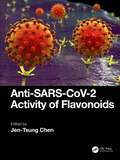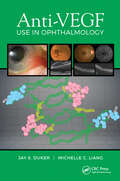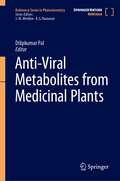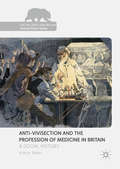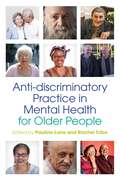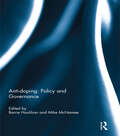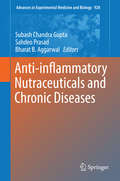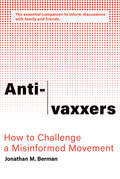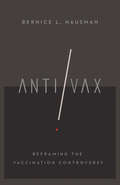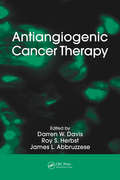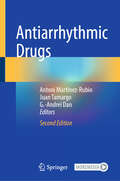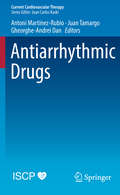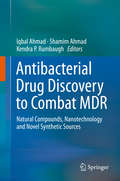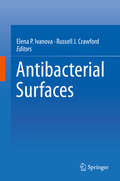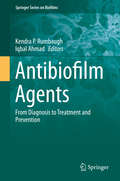- Table View
- List View
Anthropometry: Fundamentals of Application and Interpretation
by Francisco Esparza-Ros Raquel Vaquero-CristóbalThe science of Anthropometry is gaining an increasing number of followers, as it allows for a valid, reliable and cheap assessment of body composition and other interesting variables from the point of view of health and sport. However, not many books have addressed the anthropometric technique from its foundations. This book deals with issues to consider during an anthropometric assessment, such as the physical approach to the subject during the anthropometric assessment, or the factors to consider so that the data obtained are valid and reliable. It also clearly and concisely addresses the approach to body composition with anthropometry, what somatotype is, and how it is interpreted, and how anthropometry can be used to obtain proportionality values, which are very useful for the detection of sporting talents. Finally, the application of anthropometry in two of the fields where anthropometry is most used: the field of sport from the basics to elite sport, and health. All of this is conducted under the perspective of two of the world's leading experts in kinanthropometry, with the goal for the reader to acquire knowledge on every aspect of anthropometry, from the basics to in-depth knowledge of this science.
Anthropometry: Human Body Measurements and How to Use Them (Body of Knowledge in Human Factors and Ergonomics)
by Waldemar Karwowski Beata MrugalskaToday, human factors and ergonomics professionals worldwide contribute to the design and evaluation of tasks, jobs, products, environments, and systems in order to make them compatible with the needs, abilities, and limitations of people. By understanding anthropometry, professionals can ensure that our home and working environments are comfortable and designed with the human in mind. This book aims to show how an understanding of anthropometrics can influence workspace design, ergonomics in the office, ergonomics in the home, and health and safety at work. This book discusses the measurement of the human body and human variability. Anthropometry may seem to be relatively simple but the reality is that it focuses on very sophisticated aspects of how to make the products tailor-made to suit specific requirements. As a study, it is useful for a variety of purposes such as workspace design, ergonomics in the office, ergonomics in the home, and health and safety at work. These eleven chapters investigate anthropometrics and bridge the gap between theory and practice. Each chapter is supported by tables, charts, and illustrations, and a wide list of bibliographic references. The reader will develop new insights into the principles and practice of anthropometrics with this book bringing the topic right up to date. Anthropometry: Human Body Measurements and How to Use Them will be of interest to students, graduates, teachers, researchers, and general workers in industrial design, ergonomics, rehabilitation, safety, and health.
Anti-AIDS Drug Development
by Prem Mohan Baba MasanoriThis book covers the major arenas of drug development, providing understanding of the pros and cons of the various efforts of chemists and biologists to explore newer antiviral targets for HIV replication and to look for and design molecules that will have minimal toxicities.
Anti-Aging Medicine: Basics and Clinical Practice
by Hidekazu Yamada Yuji NaitoThis textbook considers aging a disease and summarizes the leading-edge research and fact on anti-aging medicine and the aging mechanism. It provides the basics and biology of aging science, followed by presenting clinical studies such as exercise, nutrition, mental health (brain, sleep), and treatment interventions. The book also discusses aging control and considers behavioral, environmental, and societal implications for healthy aging. The field of aging science is interdisciplinary, and there are much more uncertainties; thus, it is crucial to summarize what is currently known to set a foundation for future research. The International Classification of Diseases by the World Health Organization (WHO) has given the aging-related disease a subcode of XT9T. This trend advanced research of aging-related sicknesses and the concept that infirmities associated with old age can be controlled, such as cancer, dementia, and cardiovascular diseases. Basic research has progressed, and clinical applications have become available, resulting in significant social changes. As increased life expectancy is happening over the globe, we are facing unprecedented challenges, and anti-aging medicine is a key to treating population growth, environmental problems, etc., as problems for the entire planet. Anti-Aging Medicine: Basics and Clinical Practice is an English translation of the publication by the Japanese Society of Anti-Aging Medicine. It is an insightful source for healthcare professionals and scholars in anti-aging and geriatrics. It will attract pharmaceutical, Information Technology, and Artificial Intelligence industries associated with aging-responsive markets. The English translation of this book, originally in Japanese, was facilitated by artificial intelligence. A subsequent human revision of the content was done by the editors and authors.
Anti-Angiogenic Functional and Medicinal Foods
by Fereidoon Shahidi Debasis Bagchi Jack N. LossoThe ability to regulate and manipulate the generation or remodeling of blood vessels is key to the successful treatment of many chronic diseases, both oncological and non-oncological. Several bioactive compounds present in human diets are now known to exert an inhibitive effect on the either the signaling or construction of new blood vessels. The i
Anti-Angiogenic Therapy in Ophthalmology (Essentials in Ophthalmology)
by Andreas StahlThis book provides a concise overview over the pathology of retinal angiogenic diseases and explains why anti-angiogenic therapy is effective in so many patients. The reader is guided through the various clinical indications for anti-angiogenic therapy and made aware of its merits as well as current challenges and limitations. It is explained how, since its introduction for the treatment of exudative age-related macular degeneration in 2006, anti-angiogenic therapy has revolutionized the way in which we treat a range of ocular diseases. All of the authors are established experts in their respective fields who share their extensive knowledge and clinical experience with the reader. This book is both a valuable introduction to anti-angiogenic therapy in ophthalmology and a day-to-day companion for all ophthalmologists seeing patients with some of the most prevalent retinal diseases.
Anti-Cancer N-Heterocyclic Carbene Complexes of Gold: Thiol “Switch-on” Fluorescent Probes, Thioredoxin Reductase Inhibitors and Endoplasmic Reticulum Targeting Agents (Springer Theses)
by Taotao ZouThis thesis focuses on the development of gold- and non-classical platinum-based anti-cancer agents that display distinctively different anti-cancer mechanisms compared to the commonly used cisplatin. These metal complexes contain N-heterocyclic carbene (NHC) ligands which are able to form strong M-C(NHC) bonds, conferring high stability and favorable lipophilicity, reactivity and binding specificity of metal complexes on biomolecules. The author demonstrates significant advances made in anti-cancer gold(III), gold(I) and platinum(II) complexes. Detailed chemical synthesis, in vitro and/or in vivo anti-cancer activities are clearly presented including: (i) a class of Au(III) complexes containing a highly fluorescent N^N^N ligand and NHC ligand that simultaneously act as fluorescent thiol "switch-on" probes and anti-cancer agents; (ii) a dinuclear gold(I) complex with a mixed diphosphine and bis(NHC) ligand displaying favorable stability and showing significant inhibition of tumor growth in two independent mice models with no observable side effects; and (iii) a panel of stable luminescent cyclometalated platinum(II) complexes exhibiting high specificity to localize to the endoplasmic reticulum (ER) domain, inducing ER stress and cell apoptosis. These works highlight the clinical potential that gold and platinum complexes offer for cancer treatment.
Anti-Microbial Resistance in Global Perspective
by Louise Ackers Gavin Ackers-Johnson Joanne Welsh Daniel Kibombo Samuel Opio‘The Maternal Sepsis Intervention has had a profound impact on maternal mortality and antibiotic use whilst also reducing hospital costs. The Ministry of Health is keen to explore opportunities to extending the lessons learnt and integrate them in national policy-making.' -Dr. Richard Mugahi, Ministry of Health, Uganda. This open access book provides an accessible introduction to the mechanics of international development and global health text for policy-makers and students across a wide range of disciplines. Antimicrobial resistance is a major threat to the well-being of patients and health systems the world over. In fragile health systems so challenged, on a day-today basis, by the overwhelming burden of both infectious and non-communicable disease, it is easy to overlook the impacts of AMR. The Maternal Sepsis Intervention, focusing on a primary cause of maternal death in Uganda, demonstrates the systemic nature of AMR and the gains that can be made through improved Infection Prevention Control and direct engagement of laboratory testing in antibiotic prescribing.
Anti-Neutrophil Cytoplasmic Antibody (Rare Diseases of the Immune System)
by Renato Alberto Sinico Loïc GuillevinThis volume, written by well-known experts in the field, covers all aspects of Anti-Neutrophil Cytoplasmic Antibody (ANCA) Associated Vasculitis (AAV). The expression refers to a group of diseases, characterized by destruction and inflammation of small vessels. The clinical signs vary and affect several organs, such as the kidney, lung, skin, nervous system and others. The opening chapters give some historical hints, explain the genetic basis of the disease and provide insights into the pathogenesis derived from recent experimental studies and guides the reader through classification and nomenclature. A large part of the book is then devoted to a detailed description of the specific related diseases and their clinical presentations, the disease course, and potential complications. The advice regarding treatment is based on the best currently available evidence in this constantly evolving area. The book is part of Springer’s series Rare Diseases of the Immune System, which presents recently acquired knowledge on pathogenesis, diagnosis, and therapy with the aim of promoting a more holistic approach to these conditions. AAVs are systemic autoimmune diseases of unknown cause that affect small (to medium) sized blood vessels. They include granulomatosis with polyangiitis (formerly Wegener's granulomatosis), microscopic polyangiitis, and eosinophilic granulomatosis with polyangiitis (formerly Churg–Strauss syndrome). This volume will be an invaluable source of up-to-date information for all practitioners involved in the care of patients with these diseases.
Anti-SARS-CoV-2 Activity of Flavonoids
by Jen-Tsung ChenIn the past years, COVID-19 caused millions of deaths and severely damaged not only public health, but also the global economy. New variants continue to threaten human health. Thus, natural compounds for retarding infection are in high demand. This book summarizes the emerging research with flavonoids, whose application holds great promise of antivirus, anti-inflammation, antioxidative stress, and immunomodulatory. Topics include the role of flavonoids in preventing an inflammatory storm and how flavonoids interact with critical protein targets that are involved in the infection stages of COVID-19.Key Features• Highlights anti-SARS-CoV-2 drug discovery on natural products and medicinal plants• Includes all major subclasses of flavonoids that promisingly combat COVID-19 • Proposes molecular mechanisms of flavonoids against protein targets of SARS-CoV-2• Contributions from an international team of leading researchers• Provides recommendations with respect to the future research
Anti-Semitism and Psychiatry: Recognition, Prevention, and Interventions
by Mary V. Seeman H. Steven Moffic John R. Peteet Ahmed HankirFollowing World War II and the exposure of the concentration camps, psychiatry turned its attention to a vast range of cultural concerns with results that seemed to indicate a decline of stigma over time. However, it is now clear that whatever drives prejudices, especially in the case of anti-Semitism, was just dormant and perhaps not fully understood. Hate crimes and anti-Semitism broad recently re-emerged in Europe, and the United States followed shortly thereafter. The US Federal Bureau of investigation reports that New York City, which is still considered the most Jewish-friendly region in the US, experienced a 22% spike in anti-Semitic hate crimes in 2018 alone, with more extremes in other regions of the country. Neo-Nazi groups have grown stronger in the United States and abroad, often resulting in organized acts of violence. The recent Tree of Life synagogue shooting in Pittsburgh, PA demonstrated that these acts are not limited to one-on-one interactions, but sometimes as prolific, large-scale act. The medical community is not immune from biases either. The Cleveland Clinic recently fired a young doctor after she publicly declared her wishes to inject Jewish patients with lethal substances, which is only one of many hateful comments she made on social media over the course of several years. Psychiatrists in particular grapple with this as they try to serve patients of both Jewish and non-Jewish descent who struggle to process these acts of hate. Despite all of this, there is no training and no resource to guide medical professionals through these challenges. The editors of the recent Springer book, Islamophobia and Psychiatry, recognize this gap in the literature and seek to develop another high-quality text to meet this need. Written by expert clinicians in global regions where these incidents are most prevalent, the book seeks to be neither political nor opinion-based; instead, the text takes an innovative cross-cultural psychiatric interaction, similar to what was done with Springer’s new Islamophobia book. Coverage will range from foci on the social psychiatric aspects of anti-Semitism to how it may in turn infuse clinical encounters between patients and clinicians. Written by experts in this area, the insight and expertise of psychiatrists from a variety of cultural and religious backgrounds will focus on what psychiatrists need to know to combat the negative mental health impact that increasingly rise out of this particular phenomenon. Such a multi-cultural psychiatric approach has never been taken before for this topic. This discourse is the foundation for the primary goal of this book: to develop the tools needed to improve clinical outcomes for patients. Hence, this book aims to present an updated, comprehensive bio-psychosocial perspective on anti-Semitism at the interface of clinical psychiatry.
Anti-VEGF Use in Ophthalmology
by Jay Duker Michelle LiangThe introduction of anti-vascular endothelial growth factor (VEGF) agents has revolutionized therapy for a host of ocular diseases associated with leakage from normal blood vessels and pathologic blood vessel growth. Anti-VEGF Use in Ophthalmology is an all-inclusive reference designed to provide detailed, up-to-date, and clinically relevant information on the current use of anti-VEGF agents in the treatment of all ocular conditions. Drs. Jay S. Duker and Michelle C. Liang have assembled a prestigious group of contributors who pool their collective expertise in this comprehensive book. Anti-VEGF Use in Ophthalmology is split into two sections with the first providing the history of VEGF and an overview of anti-VEGF agents and different routes of drug delivery, as it is important for eye care providers to be familiar with up-to-date aspects of the medications and indications for use. The second section details the clinical uses of anti-VEGF agents in numerous ocular diseases, from the anterior segment including cornea and glaucoma to uveitis and various retinal and choroidal diseases. Each chapter in this section summarizes the disease process and utilizes high-quality ocular imaging to demonstrate the therapeutic use of the anti-VEGF agents. Some of the topics covered in Anti-VEGF Use in Ophthalmology: Neovascular Age-Related Macular Degeneration Proliferative Diabetic Retinopathy Retinal Vein Occlusion Uveitis Neovascular Glaucoma Macular Edema Retinopathy of Prematurity Corneal Disease Anti-VEGF Use in Ophthalmology combines the theory and applications of anti-VEGF agents, making it not only a great learning tool for beginners but also a useful reference tool for a wide range of eye care professionals including optometrists, residents, comprehensive ophthalmologists, as well as specialists in anterior segment, pediatrics, and vitreoretinal disease.
Anti-Viral Metabolites from Medicinal Plants (Reference Series in Phytochemistry)
by Dilipkumar PalThis reference work covers general concepts of anti-viral metabolites, classifications, ethnopharmacology, chemistry, clinical and preclinical studies focusing on different medicinal plants against various types of viral infections. Various plants have been used in medicine since ancient times and are known for their strong therapeutic effects. The book will describe potential antiviral properties of medicinal plants against a diverse group of viruses, and provide an insight to the potential plants possess for broad-spectrum antiviral effects against emerging viral infections. The book aims to target a broad audience including virologists, molecular biologist, microbiologist and scientists working with natural products as well as researchers, students, healthcare experts involved in pharmaceutical and medical field.
Anti-Vivisection and the Profession of Medicine in Britain: A Social History (The Palgrave Macmillan Animal Ethics Series)
by A.W.H. BatesThis book is open access under a CC BY 4. 0 license. This book explores the social history of the anti-vivisection movement in Britain from its nineteenth-century beginnings until the 1960s. It discusses the ethical principles that inspired the movement and the socio-political background that explains its rise and fall. Opposition to vivisection began when medical practitioners complained it was contrary to the compassionate ethos of their profession. Christian anti-cruelty organizations took up the cause out of concern that callousness among the professional classes would have a demoralizing effect on the rest of society. As the nineteenth century drew to a close, the influence of transcendentalism, Eastern religions and the spiritual revival led new age social reformers to champion a more holistic approach to science, and dismiss reliance on vivisection as a materialistic oversimplification. In response, scientists claimed it was necessary to remain objective and unemotional in order to perform the experiments necessary for medical progress.
Anti-discriminatory Practice in Mental Health Care for Older People
by Rachel Tribe Ajit Shah Maria Castro Romero Matt Broadway-Horner Musthafar Oladosu Pauline Lane Peter Cockersell Rena Kydd-Williams Siobhan SpencerExploring the key issues around anti-discriminatory practice for professionals working in mental health services, this book looks at ways to improve the health and social care of older people from minority and excluded communities. The chapters explore the issues involved in working with individuals from a range of minority groups, such as LGBT people, people with learning disabilities, people from black and minority ethnic communities, homeless people and people with dementia. The chapters cover important theory and research into discrimination, ageing and identity. Contributions from experts in the fields of mental health and working with minority groups provide practical insights into developing anti-discriminatory practice.There is also practical advice on culturally appropriate support for carers, cultural competency in end of life care, working with interpreters, and celebrating diversity, accompanied by supporting practical resources. This comprehensive book will provide mental health practitioners and students with an essential understanding of anti-discriminatory practice.
Anti-doping: Policy and Governance
by Barrie Houlihan Mike McNameeThe book addresses a series of key aspects of contemporary anti-doping policy. At the broader philosophical level, questions are asked about whether the scale of anti-doping activity and the intrusiveness of anti-doping policy in the lives of athletes is proportionate to the problem of doping. Aspects of existing anti-doping practice are also explored at the level of transnational organisations such as the EU and WADA and also at the level of the personal choices that need to be made by athletes and doctors in relation to doping control. Other contributions examine the complex issue of assessing the extent of doping and also understanding the factors that motivate athletes to use performance-enhancing drugs. The analyses provided by academic contributors are complemented by three contributions, from the World Anti-Doping Agency, UK Anti-Doping and the International Tennis Federation, which provide insights into the strategies designed to reduce the prevalence of doping in sport and the management of anti-doping processes. This book was published as a special issue of the International Journal of Sport Policy and Politics.
Anti-inflammatory Nutraceuticals and Chronic Diseases (Advances in Experimental Medicine and Biology #928)
by Bharat B. Aggarwal Subash Chandra Gupta Sahdeo PrasadThis comprehensive volume focuses on anti-inflammatory nutraceuticals and their role in various chronic diseases. Food and Drug Administration (FDA) approved drugs such as steroids, non-steroidal anti-inflammatory drugs (NSAIDS), statins and metformin have been shown to modulate inflammatory pathways, but their long-term intake has been associated with numerous side effects. This means that there is enormous potential for dietary agents that can modulate inflammatory pathways in humans. Leading experts describe the latest research on the role of anti-inflammatory nutraceuticals in preventing and treating chronic diseases.
Anti-vaxxers: How to Challenge a Misinformed Movement
by Jonathan M. BermanFrom science advocate and March on Science National Co-Chair Jonathan M. Berman, an essential takedown of the anti-vaccination movement, from its nineteenth-century antecedents to today's Facebook activists, offering strategies for refuting false claims of friends and family.Vaccines are a documented success story, one of the most successful public health interventions in history. Yet there is a vocal anti-vaccination movement, featuring celebrity activists (including Kennedy scion Robert F. Kennedy Jr. and actress Jenny McCarthy) and the propagation of anti-vax claims through books, documentaries, and social media. In Anti-Vaxxers, Jonathan Berman explores the phenomenon of the anti-vaccination movement, recounting its history from its nineteenth-century antecedents to today's activism, examining its claims, and suggesting a strategy for countering them.
Anti/Vax: Reframing the Vaccination Controversy (The Culture and Politics of Health Care Work)
by Bernice L. HausmanAntivaxxers are crazy. That is the perception we all gain from the media, the internet, celebrities, and beyond, writes Bernice Hausman in Anti/Vax, but we need to open our eyes and ears so that we can all have a better conversation about vaccine skepticism and its implications.Hausman argues that the heated debate about vaccinations and whether to get them or not is most often fueled by accusations and vilifications rather than careful attention to the real concerns of many Americans. She wants to set the record straight about vaccine skepticism and show how the issues and ideas that motivate it—like suspicion of pharmaceutical companies or the belief that some illness is necessary to good health—are commonplace in our society.Through Anti/Vax, Hausman wants to engage public health officials, the media, and each of us in a public dialogue about the relation of individual bodily autonomy to the state's responsibility to safeguard citizens' health. We need to know more about the position of each side in this important stand-off so that public decisions are made through understanding rather than stereotyped perceptions of scientifically illiterate antivaxxers or faceless bureaucrats. Hausman reveals that vaccine skepticism is, in part, a critique of medicalization and a warning about the dangers of modern medicine rather than a glib and gullible reaction to scaremongering and misunderstanding.
Antiangiogenic Cancer Therapy
by James L. Abbruzzese Roy S. Herbst Darren W. DavisTop Investigators Explore the Complexities of Angiogenesis Cancer ResearchThe targeting of tumor angiogenesis has evolved into one of the most widely pursued therapeutic strategies. However, as of yet, no antiangiogenic agent used as a monotherapy has demonstrated a survival benefit in a randomized Phase III trial. The combination of bev
Antiarrhythmic Drugs
by Antoni Martínez-Rubio Juan Tamargo G. Andrei DanThis extensively updated edition reviews current and potential future therapies for cardiac arrhythmias. Developing the highly practical format of the original, this edition provides a thorough guide for the use of pharmaceuticals in the management of the condition and is focused on providing a clinical manual for arrhythmia treatment.Antiarrhythmic Drugs builds on the current understanding of pathophysiological mechanisms and insights gained from previous studies of therapeutic interventions. It is designed to establish the baseline level of knowledge that a cardiovascular professional needs to know on a day-to-day basis.
Antiarrhythmic Drugs (Current Cardiovascular Therapy)
by Gheorghe-Andrei Dan Antoni Martínez-Rubio Juan TamargoThis volume reviews current and potential future therapies for arrhythmias. It is a highly practical guide for the use of pharmaceuticals in the management of the discipline, and has been written in a simple quick-access format.Antiarrhythmic Drugs builds on the current understanding of pathophysiological mechanisms and insights gained from previous studies of therapeutic interventions. It is designed to establish the baseline level of knowledge that a cardiovascular professional needs to know on a day-to-day basis.
Antibacterial Drug Discovery to Combat MDR: Natural Compounds, Nanotechnology and Novel Synthetic Sources
by Iqbal Ahmad Kendra P. Rumbaugh Shamim AhmadThis book compiles the latest information in the field of antibacterial discovery, especially with regard to the looming threat of multi-drug resistance. The respective chapters highlight the discovery of new antibacterial and anti-infective compounds derived from microbes, plants, and other natural sources. The potential applications of nanotechnology to the fields of antibacterial discovery and drug delivery are also discussed, and one section of the book is dedicated to the use of computational tools and metagenomics in antibiotic drug discovery. Techniques for efficient drug delivery are also covered. The book provides a comprehensive overview of the progress made in both antibacterial discovery and delivery, making it a valuable resource for academic researchers, as well as those working in the pharmaceutical industry.
Antibacterial Surfaces
by Elena Ivanova Russell Crawford'Antibacterial Surfaces' covers the advances being made in the design of antibacterial surfaces, which have the ability to either prevent the initial attachment of bacterial cells, or kill any cells that come into contact with these surfaces. This book discusses the mechanisms associated with the attachment of bacteria to surfaces and the main strategies currently being employed to control the initial attachment processes. These strategies are expanded upon in the subsequent chapters, where the definition and description of antibacterial surfaces are clarified, as are the mechanisms that come into play when determining the effectiveness of an antibacterial surface. Subsequent chapters discuss a number of naturally occurring antibacterial surfaces, the methods currently being used for producing synthetic antibacterial surfaces, and the current and potential applications of such materials. This book will be of great interest to people who work with materials that need to remain free of bacterial films, from designing safer biomedical implants to the production of self-cleaning materials where the prevention of biofilm formation has significant economic advantages.
Antibiofilm Agents: From Diagnosis to Treatment and Prevention (Springer Series on Biofilms #8)
by Iqbal Ahmad Kendra P. RumbaughThis book provides a survey of recent advances in the development of antibiofilm agents for clinical and environmental applications. The fact that microbes exist in structured communities called biofilms has slowly become accepted within the medical community. We now know that over 80% of all infectious diseases are biofilm-related; however, significant challenges still lie in our ability to diagnose and treat these extremely recalcitrant infections. Written by experts from around the globe, this book offers a valuable resource for medical professionals seeking to treat biofilm-related disease, academic and industry researchers interested in drug discovery and instructors who teach courses on microbial pathogenesis and medical microbiology.
